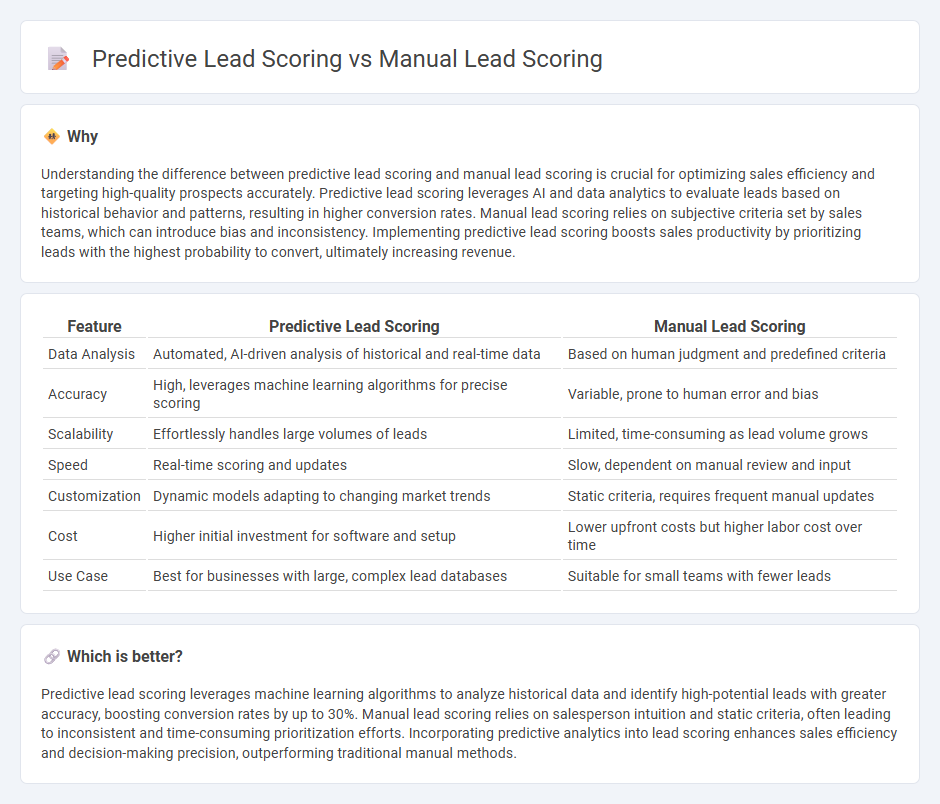
Predictive lead scoring leverages machine learning algorithms to analyze vast datasets and identify high-potential prospects with greater accuracy compared to manual lead scoring, which relies on subjective human judgment and limited historical data. Companies using predictive lead scoring report up to a 50% increase in lead qualification efficiency and improved conversion rates. Discover how integrating predictive lead scoring can transform your sales strategy.
Why it is important
Understanding the difference between predictive lead scoring and manual lead scoring is crucial for optimizing sales efficiency and targeting high-quality prospects accurately. Predictive lead scoring leverages AI and data analytics to evaluate leads based on historical behavior and patterns, resulting in higher conversion rates. Manual lead scoring relies on subjective criteria set by sales teams, which can introduce bias and inconsistency. Implementing predictive lead scoring boosts sales productivity by prioritizing leads with the highest probability to convert, ultimately increasing revenue.
Comparison Table
| Feature | Predictive Lead Scoring | Manual Lead Scoring |
|---|---|---|
| Data Analysis | Automated, AI-driven analysis of historical and real-time data | Based on human judgment and predefined criteria |
| Accuracy | High, leverages machine learning algorithms for precise scoring | Variable, prone to human error and bias |
| Scalability | Effortlessly handles large volumes of leads | Limited, time-consuming as lead volume grows |
| Speed | Real-time scoring and updates | Slow, dependent on manual review and input |
| Customization | Dynamic models adapting to changing market trends | Static criteria, requires frequent manual updates |
| Cost | Higher initial investment for software and setup | Lower upfront costs but higher labor cost over time |
| Use Case | Best for businesses with large, complex lead databases | Suitable for small teams with fewer leads |
Which is better?
Predictive lead scoring leverages machine learning algorithms to analyze historical data and identify high-potential leads with greater accuracy, boosting conversion rates by up to 30%. Manual lead scoring relies on salesperson intuition and static criteria, often leading to inconsistent and time-consuming prioritization efforts. Incorporating predictive analytics into lead scoring enhances sales efficiency and decision-making precision, outperforming traditional manual methods.
Connection
Predictive lead scoring uses data-driven algorithms to assign scores based on historical sales performance, while manual lead scoring relies on human judgment and predefined criteria. Integrating both approaches enhances accuracy by combining predictive analytics with expert insights, improving lead prioritization. This hybrid method increases conversion rates and optimizes sales team efficiency through targeted engagement.
Key Terms
Criteria Selection
Manual lead scoring relies on predefined criteria such as demographic information, firmographics, and past interactions, which are selected based on human judgment and experience. Predictive lead scoring uses machine learning algorithms to analyze historical data and identify patterns that automatically determine the most relevant criteria for lead qualification. Explore the benefits and challenges of both methods to optimize your lead scoring strategy effectively.
Automation
Manual lead scoring relies on human input to assign scores based on predefined criteria, which can be time-consuming and prone to bias, limiting scalability and efficiency. Predictive lead scoring leverages automation through AI and machine learning algorithms to analyze vast datasets, enhancing accuracy and prioritizing leads with higher conversion potential. Explore the advantages of automated predictive lead scoring to optimize your sales funnel.
Data Analysis
Manual lead scoring relies on human-driven data analysis to assign scores based on predefined criteria such as demographics, firmographics, and past interactions, often resulting in static models limited by subjective judgment. Predictive lead scoring utilizes machine learning algorithms and vast datasets, analyzing behavioral patterns and engagement metrics to generate dynamic, data-driven scores that improve accuracy and sales efficiency. Explore the detailed comparative insights on how data analysis shapes both scoring methods and impacts lead prioritization.
Source and External Links
Set up lead scoring - Ontraport - Manual lead scoring involves creating numeric fields for "Manual Lead Score" and "Adjusted Lead Score," allowing teams to manually adjust scores based on customer interactions and automate follow-up actions accordingly.
Understanding Lead Scoring: How to Build a Scoring Framework - Shopify - Manual lead scoring requires identifying key lead attributes, assigning point values to those attributes, creating tiers for leads based on scores, and refining the process to prioritize likely converters.
Lead Scoring: Simplify the Process with Leadfeeder - Manual lead scoring entails assigning numerical or qualitative scores to leads based on criteria like demographics and engagement, allowing nuanced and flexible evaluation but requiring significant time and effort from teams.
 dowidth.com
dowidth.com